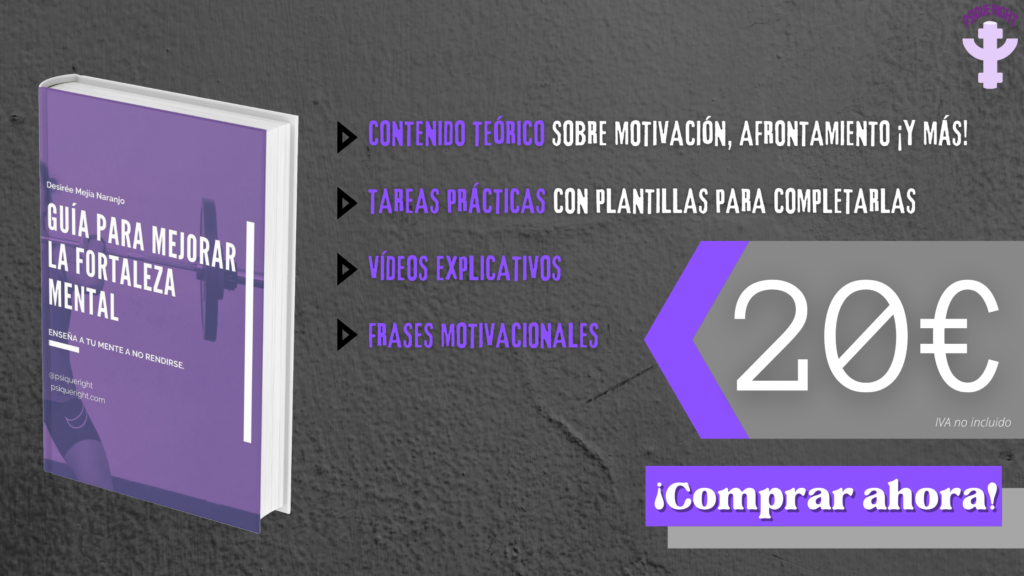¡GANA EN FORTALEZA MENTAL CON ESTA GUÍA!


Resilience is a psychological skill that has been growing in popularity ever since Positive Psychology stole the scene. Truth is, given its impact on mental well-being, it’s worth our while to dig into this concept and try to respond to the most interesting question it brings up: can it be improved?
Resilience has traditionally been used to define the ability of certain materials to recover its size and shape after deformation caused by an external force. Ever since positive psychology rolled around during the 90s, literature began to use this term to refer to this same condition applied to human behavior.
In this sense, resilience is considered a positive adaptation to a negative situation. Being resilient would be the ability to stay within stable functional levels both physically and mentally despite adversity (Moran et. al, 2014 in Gines-Silva, et. al, 2019).
But, don’t we all recover some sense of normality after a traumatic event? Yes, but the difference is how. Imagine we all have an energy bar that can be charged with positive events (good night sleep, proper stress management, etc.) or emptied by negative occurrences. These aversive events would consume a non-resilient person’s energy and, after a while, these levels would return to their initial state. A resilient person doesn’t suffer this energy deficit, but instead actually increases their energy levels.
Now, we need to know where this resilience comes from. Maybe we’re born with it, maybe it emerges from personal experience, or it could be a mix of both! That’s how we wind up with three lines of investigation to conceptualize resilience, depending on whether they consider it a trait, a result or a process (Hu, Zhang & Whang, 2015 in Gines-Silva et. al, 2019).
To satisfy my perennial desire of shying away from black-or-white mentality, let’s stick to this last concept. We all have the potential to be resilient under given circumstances. Great. So, how can I help jump-start this process?
Discovering our potential ain’t going to happen looking outside. It all starts within. I know, it sounds like some hippy, acid-trip thing; but I’m actually talking about self-concept, motivation or self-efficacy. Having an answer for questions about why you’re here, how can you reach your goals or if you’re able to even reach them is the first step towards resilience.
However, we have learned that certain situational elements can help push resilience into existence. And the reality is that being in extreme conditions that undoubtedly call for this skill (life-death situations, sustained psychological trauma, etc.) isn’t as common as we might think. And we can’t be waiting for life to throw us tremendous curve balls to learn how to break into our resilience. So, let’s use what we got: CrossFit!

«I have my gold medals somewhere in a box. I have my silver medal with me. We all need to lose.» – Katrin Davidsdottir
On her second place at Regionals in 2018 as the reigning Fittest on Earth.
- Gínez-Silva, M. J., Astorga, C. M., & Urchaga-Litago, J. D. (2019). Resiliencia psicológica a través de la edad y el sexo. Revista INFAD de Psicología. International Journal of Developmental and Educational Psychology., 4(1), 85-94.
- Grafton, E., Gillespie, B., & Henderson, S. (2010, November). Resilience: the power within. In Oncology nursing forum (Vol. 37, No. 6).

La resiliencia es una habilidad psicológica que ha ido creciendo en popularidad con el «boom» de la Psicología Positiva. Y lo cierto es que dada su importancia para el bienestar psicológico, merece la pena indagar en este concepto para responder a la pregunta más importante que sugiere: ¿la resiliencia se puede aprender?
Antes de proseguir, definamos el concepto. Éste, se ha usado tradicionalmente para definir la capacidad de un material para recuperar su estado inicial tras haber sido sometido a un agente perturbador. Desde la década de los 90, empezó a usarse para describir esa misma cualidad en el comportamiento humano.
En este sentido, la resiliencia se considera una adaptación positiva a una situación adversa. Ser resiliente sería esa capacidad para mantenerse dentro de los niveles estables de funcionamiento físico y psicológico pese a la adversidad (Morán, Vicente, Sánchez y Montes, 2014 en Ginés-Silva, et. al, 2019).
Pero, de algún modo todos recuperamos la normalidad tras un evento traumático, ¿no? La diferencia está en el cómo. Imagina que todos tenemos una barrita de energía vital. Un evento negativo consume la energía vital de la persona no-resiliente y con el tiempo los niveles vuelven a su estado inicial. Una persona resiliente no sólo no sufre ese déficit sino que su energía vital crece a consecuencia del evento (sobrevivir vs. supervivir).
El siguiente paso para entender la resiliencia es ver de dónde viene. Si se viene con ella de serie o aparece fruto de nuestras experiencias, ¡o quizá sea una mezcla de ambas! Así pues, hay tres abordajes para conceptualizar la resiliencia: quienes la consideran como un rasgo, como un resultado o como un proceso (Hu, Zhang y Wang, 2015 en Ginés-Silva et. al, 2019).
Para satisfacer mi eterno deseo de moverme en los grises y no pensar en blanco o negro, vamos a quedarnos con esto último. El potencial para ser resiliente reside de forma natural en cada uno y si se dan ciertas circunstancias, ésta puede emerger para ayudarnos frente a la adversidad. Ahora bien, ¿cómo puedo «precipitar» este proceso?
Descubrir este potencial en ti mismo empieza desde dentro. Y aunque esto sin duda tiene su vertiente espiritual, me quiero referir más a constructos como el autoconocimiento, la motivación o la autoeficacia (más pertinentes a este blog). Tener algo que responder al por qué de tu existencia, al cómo y al cuándo es un prerrequisito esencial para la resiliencia.
Pero como hemos visto, tienen que darse ciertos elementos situacionales para que esta habilidad emerja. Y la realidad es que no todos nos vamos a ver en situaciones extremas que faciliten este proceso, ni vamos a estar esperando a que esos suceda para aprender a ser resilientes. Así que usemos lo que tenemos: ¡el CrossFit!

«Tengo mis medallas de oro metidas en una caja. La medalla de plata la llevo siempre encima. Todos necesitamos perder.» – Katrin Davidsdottir
Sobre su segundo puesto en Regionals en 2018.
- Gínez-Silva, M. J., Astorga, C. M., & Urchaga-Litago, J. D. (2019). Resiliencia psicológica a través de la edad y el sexo. Revista INFAD de Psicología. International Journal of Developmental and Educational Psychology., 4(1), 85-94. - Grafton, E., Gillespie, B., & Henderson, S. (2010, November). Resilience: the power within. In Oncology nursing forum (Vol. 37, No. 6).